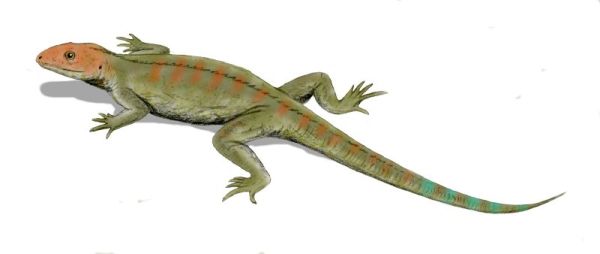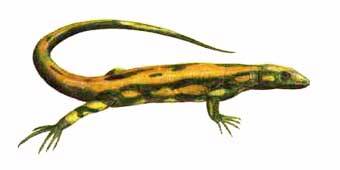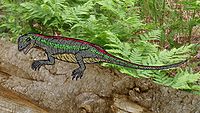
Hylonomus lyelli, an early reptile from the Late Carboniferous of Nova Scotia, Canada, illustration by Nobu Tamura (Wikipedia)
| Eureptilia | ||
| The Vertebrates | Protorothyrididae |
| Vertebrates Home | Vertebrate | Vertebrate |
|
Abreviated Dendrogram
Amniota
├─Synapsida
└─┬─Anapsida
└─Eureptilia
├─Captorhinidae
└─"Protorothyrididae"
├─Brouffia
└─○Romeriida
└─┬─Paleothyris
└─┬─Hylonomus
└─┬─┬─Anthracodromeus
│ ├─Cephalerpeton
│ └─Protorothyris
└─○Diapsida |
Contents
Overview |
 Hylonomus lyelli, an early reptile from the Late Carboniferous of Nova Scotia, Canada, illustration by Nobu Tamura (Wikipedia) |
The "Protorothyrididae" (or "Protorothyridae") are a basal group of terrestrial eureptiles. Although not that closely related to them, they were similar to modern lizards in appearance and were generalized, small, insectivorous animals. Most of them are known from the Late Carboniferous of North America and Europe. According to recent studies, they form a paraphyletic group, which means that not all descendants of the last common ancestor of this group are included. In case of the protorothyridids, the diapsids (the sister clade of Anthracodromeus + Cephalerpeton + Protorothyris) are traditionally excluded. If the Early Permian genus Thuringothyris is also considered a protorothyridid the group even becomes polyphyletic because Thuringothyris is more closely related to the Captorhinidae while all other protorothyridids are closer to the Diapsida. The para- or polyphyly of a group is indicated by using its name enclosed in quotation marks. Zidane 080421 the Palaeos wiki
 |
| Hylonomus lyelli, a protorothyrid from the Late Carboniferous of Nova Scotia. Image from Cox et al. (1988). |
Protorothyrididae: Small, short legged, lizard-like insectivores. Carroll & others place as early amniote stem group. Hylonomus
Middle Carboniferous to Early Permian of North America & ?Europe.
Eureptilia:: Diapsida + *. Unfenestrated skull?
Comments: In evolutionary systematics, the Protorothyrididae are the stem-lineage from which all other amniotes evolved, and hence are more basal than in cladistics. In the cladistic analysis of Müller & Reisz 2006 they are a paraphyletic grade rather than clade, and the stem lineage from which the Diapsida evolved (cladistics). MAK120317
Links: Protorothyrididae; reptiles; Dinosaurier Album 2 OK, so the grass is anachronistic. I still love this page); H- Paleontology and Geology Glossary- H entry on Hylonomus). ATW030210. Paeobiology database,
Brouffia Brouffia orientalis
Late Carboniferous of Nyr'any, Czech Republic.
Eureptilia : Romeriida + *.
Comments: More basal than Paleothyris , according to Müller & Reisz 2006. MAK101001
 Romeriida Paleothyris + Diapsids
Romeriida Paleothyris + Diapsids
Late Carboniferous to Recent.
Eureptilia : Captorhinidae + * : Paleothyris + Diapsida.
separation of the tabular bone from the opisthotic bone, ventrally keeled anterior pleurocentra, long and slender carpi and tarsi, and overlapping metapodials.
Comments: Phylogenetically defined by Laurin & Reisz 1995 as the last common ancestor of Paleothyris and diapsids, and all its descendants.. It is named after Alfred Sherwood Romer. Protorothyridids were once placed in the family Romeriidae along with the captorhinid Romeria. Because Romeria is now considered to be a captorhinid, and Captorhinidae is placed outside of Romeriida, the genus is excluded from the clade. Recent studies have proposed that Protorothyrididae is a paraphyletic taxon (Müller & Reisz 2006). Therefore, it is possible that many protorothyridids do not lay within the clade Romeriida. Smokeybjb 091231 (text and image from Wikipedia)
 Paleothyris Paleothyris acadiana Carroll 1969
Paleothyris Paleothyris acadiana Carroll 1969
Middle Pennsylvanianof Nova Scotia.
Postorbital far from occiput, Parasphenoid teeth present, Trunk neural arches narrow Humerus long and slender ( Laurin & Reisz 1995 p.203) (generic protorothyrid characteristics) Increase in the strength of the jaws when compared with basal tetrapods. Pterygoideus supplements the adductors in pulling the jaw up and forward Palatal teeth small, perhaps role was to to hold food, tongue may have been toughened on the upper surface to work against palatal teeth. Stapes heavy as in basal tetrapods, so hearing probably limited to low frequency vibrations. There was no otic notch and hence no tympanium. (all these features were typical no doubt for protorothyrids and basal eureptiles as a whole) (Benton, 2000, pp.104-5)
Comments: Skull better known than that of Hylonomus (Benton, 2000, p.104). May have been nocturnal. Laurin & Reisz 1995 used Paleothyris instead of Protorothyrididae because the latter is poorly defined and paraphyletic.
Links: Wikipedia, Paleothyris - Prehistoric Land Reptiles MAK101001
Image from Paleopedia - Cotylosaurs
Hylonomus Hylonomus lyelli
Early Pennsylvanian epoch in Nova Scotia.
Romeriida ::: (Protorothyris + Diapsida) + *.
Comments: Earliest known Sauropsid, but not the most primitive reptile. This implies that reptilian evolution had already been underway several millions of years.
Links: Paeobiology database, Wikipedia MAK101001
Protorothyris: Protorothyris archeri, Protorothyris morani
Early Permian of Texas and West Virginia.
tabular (which has been lost in Captorhinus, this would have had no effect on the adductor muscles from inside the skull roof) limited to the occiput and rested without sutural attachment upon the squamosal. In early works this is part of the morphological sequence, Protorothyris—Romeria—Captorhinus (Fox, 1964), in cladistic analysies the sequence goes the other way, with Captorhinids more basal. ( Laurin & Reisz 1995; Muller & Reisz 2006.
Links: Paeobiology database, Wikipedia MAK101001
checked ATW031014
Using this material. All material by ATW is public domain and may be freely used in any way (also any material jointly written by ATW and MAK). All material by MAK is licensed Creative Commons Attribution License Version 3.0, and may be freely used provided acknowedgement is given. All Wikipedia material is either Gnu Open Source or Creative Commons (see original Wikipedia page for details). Other graphics are copyright their respective owners